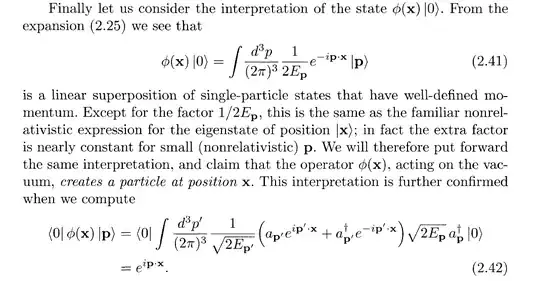The mode expansion of a field in QFT is $$\phi(\vec x)= \int \frac{d^3p}{(2\pi)^3}\frac{1}{\sqrt{w_p}}\left(a_p^\dagger e^{-i\vec p\cdot\vec x}+a_p e^{i\vec p\cdot\vec x}\right)\quad .$$
From what I have understood, we have taken the analogy from SHO in QM to construct this and here, every mode expansion represents a particle of definite momenta in momentum space. Talking about the field $\phi$, it doesn't refer to a single particle localized in space sort of thing. $\vec x$ here is a parameter here.
My problem arises from the interpretation of the propagator given in P&S (pg.24)
In Eq.(2.41), the RHS implies that $\phi(\vec x)|0\rangle$ is the superposition of definite momenta particles in momentum space. The next line pulling out the NR interpretation is throwing me off.
Firstly, In Quantum Mechanics, we said that there is nothing such as a free particle with definite momenta. Rather, we proceeded with the wave packet description. We did not interpret $|p\rangle$ in the Fourier expansion of $|x\rangle$ as particles in momentum space. So, the one-to-one mapping between $\phi(x)|0\rangle$ in QFT with $|x\rangle$ in QM -- just because it looks similar -- is not sitting well with me.
Moreover, the position eigenstates in QM were localized and we expanded our states in this basis. The $|x\rangle$s were not physical states -- they were not normalized. In QFT, our system is not a single particle to begin with. I'm very confused about how to make sense of creation of a particle at some localized point in space in QFT which in turn is making the description of the propagator being $\langle0|\phi(x)\phi(y)|0\rangle$ difficult to understand because i don't see how $\phi(y)|0\rangle$ is creating a particle at point y in space.
A very similar question has been asked before but the answer to it was along the lines that it looks like the equation in QM. This answer doesn't satisfy me.
